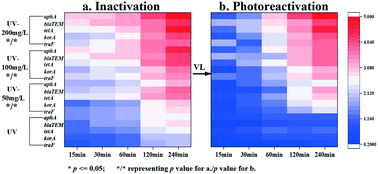Heterogeneous UV disinfection aided by ZnO/Al2O3 composites for inhibiting antibiotic resistant bacteria photoreactivation and gene recovery†
Abstract
Photoreactivation has limited antibiotic resistant bacteria (ARB) and gene (ARG) reduction by ultraviolet (UV) heterogeneous disinfection. ZnO/Al2O3 particles where ZnO length ranged around 400 nm was synthesized by template–hydrothermal method. Subsequently particle aided UV system was built to investigate the inhibitions on ARB (Escherichia coli carrying RP4 plasmid) photoreactivation and gene (three ARGs and two mobile genetic elements) recoveries after disinfection. All bacterial inactivation and 5 log gene reduction could be achieved within 5 min and 4 h respectively, and significant inhibitions on bacteria and gene recoveries after photoreactivation were observed, compared with individual UV. Hydroxyl radicals which were responsible for photoreactivation inhibition were detected during ZnO photocatalysis. The pathway of intracellular gene inactivation by extracellular ˙OH was identified as a carpet model. Briefly, ˙OH could destroy membrane, thus intracellular ARGs had accesses to ˙OH and were inactivated. Subsequently the broken areas with negative charge were reclosed via electrostatic attraction due to the limited Zn2+ from zinc oxide, but the function of membrane cannot be restored. Our work further provided profound theoretical supports for practical application of antibiotic resistance removal by UV with ZnO aided method in wastewater treatment.



 Please wait while we load your content...
Please wait while we load your content...